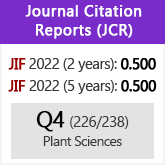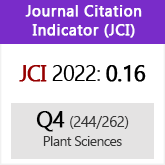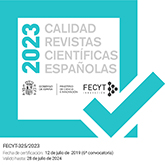Ecological responses of epilithic diatoms and aquatic macrophytes to fish farm pollution in a Spanish river
DOI:
https://doi.org/10.3989/ajbm.2007.v64.i2.177Keywords:
Spanish river, fish farm pollution, diatom and macrophyte responsesAbstract
We examined the ecological responses of epilithic diatoms and aquatic macrophytes to organic pollution and nutrient enrichment caused by a trout farm effluent in the upper Tajuña River (Guadalajara, Spain). Four sampling sites were selected over the study area: one site (S-1) placed upstream from the trout farm was used as a reference station; sampling sites S-2, S-3 and S-4 were set, respectively, about 10, 100 and 1000 metres downriver of the trout farm outlet. The river bottom was mainly stony with cobbles and pebbles at S-1, S-3 and S-4, but at S-2 it was covered by a thick layer of organic sediment. Although some macrophyte species (Apium nodiflorum, Groenlandia densa) were either absent or fewer downstream of the farm, abundance (% coverage) and diversity (number of species) for the aquatic macrophyte community as a whole increased. In contrast, epilithic diatoms were completely absent at S-2, and some species (Diploneis parma, Fragilaria ulna, Gomphonema angustatum, Nitzschia dissipata) were also absent at S-3 and S-4. Indeed, diatom diversity (number of species) was lower at S-3 and S-4 than at S-1. However, diatom abundance (cells/cm2) was higher at S-3 and S-4 than at S-1. Biological indices for diatoms (IBD, TDI) indicated a better water quality at S-1 than at S-3 and S-4, with a clear tendency to improve with distance from the fish farm. In contrast, biological indices of macrophytes (IM, IVAMG) indicated a similar water quality at S-1, S-3 and S-4, but with bad water quality at S-2. We conclude that epilithic diatoms may be more useful than aquatic macrophytes for biological monitoring of fish farm pollution in fluvial ecosystems. However, as historical and seasonal factors may be relevant to understanding the distribution, abundance and diversity of primary producers in running waters, further studies on long-term seasonal changes are needed to improve the use of macrophyte and diatom indices in assessing fish farm pollution.
Downloads
References
Alabaster, J.S. 1982. Surveys of fish farm effluents in some EIFAC countries. EIFAC Technical Paper 41: 5-20.
Allan, J.D. 1995. Stream ecology: structure and function of running waters.Chapman & Hall, London.
American Public Health Association. 1992. Standard methods for the examination of water and wastewater, 18th edition. APHA-AWWA-WPCF, Washington, DC.
Camargo, J.A. 1992. Temporal and spatial variations in dominance, diversity and biotic indices along a limestone stream receiving a trout farm effluent. Water Air Soil Pollut. 63: 343-359. doi:10.1007/BF00475501
Camargo, J.A. 1994. The importance of biological monitoring for the ecological risk assessment of freshwater pollution: a case study. Environ. Inter.20: 229-238. doi:10.1016/0160-4120(94)90140-6
Camargo, J.A., Alonso, A. & de la Puente, M. 2005. Eutrophication downstream from small reservoirs in mountain rivers of Central Spain. Water Res. 39: 3376-3384. doi:10.1016/j.watres.2005.05.048 PMid:16039693
Camargo, J.A. & Alonso, A. 2006. Ecological and toxicological effects of inorganic nitrogen pollution in aquatic ecosystems: a global assessment. Environ. Inter. 32: 831-849. doi:10.1016/j.envint.2006.05.002 PMid:16781774
Carr, O.J. & Goulder, R. 1990. Fish farm effluents in rivers: effects on inorganic nutrients, algae and the macrophyte Ranunculus penicillatus. Water Res. 24: 639-647. doi:10.1016/0043-1354(90)90197-E
Casas, C., Brugués, M., Cros, R.M. & Sérgio, C. 2006. Handbook of mosses of the Iberian Peninsula and the Balearic Islands. Institut d’Estudis Catalans, Barcelona.
Cirujano, S. & Medina, L. 2002. Plantas acuáticas de las lagunas y humedales de Castilla-La Mancha.Real Jardín Botánico (CSIC) y Junta de Comunidades Castilla-La Mancha, Madrid.
Daniel, H., Bernez, I., Haury, J. & Le Coeur, D. 2005. The ability of aquatic macrophytes to assess fish farm pollution in two salmon rivers. Hydrobiologia 551: 183-191. doi:10.1007/s10750-005-4460-3
Descy, J.P. & Coste, M. 1991. A test of methods for assessing water quality based on diatoms. Verhand. Internat. Verein. Limnol. 24: 2112-2116.
Garcia-Ruiz, R. & Hall, G.H. 1996. Phosphorus fractionation and mobility in the food and faeces of hatchery reared rainbow trout (Onchorhynchus mykiss). Aquaculture 145: 183-193. doi:10.1016/S0044-8486(96)01329-4
Gosselain, V., Coste, M., Campeau, S., Ector, L., Fauville, C., Delmas, F., Knoflacher, M., Licursi, M., Rimet, F., Tison, J., Tudesque, L. & Descy, J.-P. 2005. A large-scale stream benthic diatom database. Hydrobiologia 542: 151-163. doi:10.1007/s10750-004-7423-1
Hauer, F.R. & Lamberti, G.A. (eds.). 1996. Methods in stream ecology. Academic Press, San Diego.
Hering, D., Johnson, R.K. & Buffagni, A. 2006. Linking organism groups: major results and conclusions from the STAR project. Hydrobiologia 566: 109-113. doi:10.1007/s10750-006-0098-z
Johnson, R.K., Hering, D., Furse, M.T. & Verdonschot, P.F.M. 2006. Indicators of ecological change: comparison of the early response of four organism groups to stress gradients. Hydrobiologia 566: 139-152. doi:10.1007/s10750-006-0100-9
Jones, J.G. 1990. Pollution from fish farms. J. Inst. Water Environ. Man. 4: 14-18. doi:10.1111/j.1747-6593.1990.tb01552.x
Kaspar, H.F., Grahame, H.H. & Holland, A.J. 1988. Effects of sea cage salmon farming on sediment nitrification and dissimilatory nitrate reductions. Aquaculture 70: 333-344. doi:10.1016/0044-8486(88)90117-2
Kelly, M.G. 1998. Use of the Trophic Diatom Index to monitor eutrophication in rivers. Water Res. 32: 236-242. doi:10.1016/S0043-1354(97)00157-7
Kelly, M.G.& Whitton, B.A. 1995. The Trophic Diatom Index: a new index for monitoring eutrophication in rivers. J. Appl. Phycol. 7: 433-444. doi:10.1007/BF00003802
Krammer, K. & Lange-Bertalot, H. 1986. Bacillariophyceae. 1. In: Ettl, H., Gerloff, J., Heynig, H. & Mollenhauer, D. (eds.), Süßwasserflora von Mitteleuropa. Gustav Fischer Verlag, Stuttgart, New York.
Krammer, K. & Lange-Bertalot, H. 1988. Bacillariophyceae. 2. In: Ettl, H., Gerloff, J., Heynig, H. & Mollenhauer, D. (eds.), Süßwasserflora von Mitteleuropa. Gustav Fischer Verlag, Stuttgart, New York.
Krammer, K. & Lange-Bertalot, H. 1991a. Bacillariophyceae. 3. In: Ettl, H., Gerloff, J., Heynig, H. & Mollenhauer, D. (eds.), Süßwasserflora von Mitteleuropa. Gustav Fischer Verlag, Stuttgart, New York.
Krammer, K. & Lange-Bertalot, H. 1991b. Bacillariophyceae. 4. In: Ettl, H., Gerloff, J., Heynig, H. & Mollenhauer, D. (eds.), Süßwasserflora von Mitteleuropa. Gustav Fischer Verlag, Stuttgart, New York.
Leira, M. & Sabater, S. 2005. Diatom assemblages distribution in Catalan rivers, NE Spain, in relation to chemical and physiographical factors. Water Res. 39: 73-82. doi:10.1016/j.watres.2004.08.034 PMid:15607166
Moreno, J.L., Navarro, C. & de las Heras, J. 2006. Propuesta de un índice de vegetación acuática (IVAM) para la evaluación del estado trófico de los ríos de Castilla-La Mancha: comparación con otros índices bióticos. Limnetica 25: 821-838.
Murphy, M.L. 1998. Primary production. In: Naiman, R.J. & Bilby, R.E. (eds.), River ecology and management. Lessons from the Pacific Coastal Ecoregion. Springer Verlag, New York: 144-68.
Nordvarg, L. & Johansson, T. 2002. The effects of fish farm effluents on the waters quality in the Aland archipelago, Baltic Sea. Aquac. Eng. 25: 253-279.
Preston, C.D., Sheail, J., Armitage, P. & Davy-Bowker, J. 2003. The long-term impact of urbanisation on aquatic plants: Cambridge and the River Cam. Science Total Environ. 314–316: 67–87. doi:10.1016/S0048-9697(03)00097-4 PMid:14499527
Prygiel, J. & Coste, M. 2000. Guide méthodologique pour la mise en oeuvre de l’Indice Biologique Diatomées (IBD). Norme Française T 90-354, France.
Schneider, S. & Melzer, A. 2003. The trophic index of macrophytes (TIM): a new tool for indicating the trophic state of running waters. Internat. Rev. Hydrobiol. 88: 49-67. doi:10.1002/iroh.200390005
Solbé, J.F. 1982. Fish farm effluents: a United Kingdom survey. EIFAC Technical Paper 41: 29-55.
Springe, G., Sandin, L., Briede, A. & Skuja, A. 2006. Biological quality metrics: their variability and appropriate scale for assessing streams. Hydrobiologia 566: 153-172. doi:10.1007/s10750-006-0099-y
Suárez, M.L., Mellado, A., Sánchez-Montoya, M.M. & Vidal-Abarca, M.R. 2005. Propuesta de un índice de macrófitos (IM) para evaluar la calidad ecológica de los ríos de la cuenca del Segura. Limnetica 24: 305-318.
Szoszkiewicz, K., Ferreira, T., Korte, T., Baattrup-Pedersen, A., Davy-Bowker J. & O’Hare, M. 2006. European river plant communities: the importance of organic pollution and the usefulness of existing macrophyte metrics. Hydrobiologia 566: 211-234. doi:10.1007/s10750-006-0094-3
Thiébaut, G., Tixier, G., Guérold, F. & Muller, S. 2006. Comparison of different biological indices for the assessment of river quality: application to the upper river Moselle (France). Hydrobiologia 570: 159-164. doi:10.1007/s10750-006-0176-2
Vannote, R.L., Minshall, G.W., Cummins, K.W., Sedell, J.R. & Cushing, C.E. 1980. The river continuum concept. Can. J. Fish. Aquat. Sci. 37: 130-137.
Villanueva, V.D., Queimalinos, C., Modenutti, B. & Ayala, J. 2000. Effects of fish farm effluents on the periphyton of an Andean stream. Arch. Fish. Mar. Res. 48: 283-294.
Wetzel, R.G. 2001. Limnology: lake and rivers ecosystems, 3rd edition. Academic Press, San Diego.
Wetzel, R.G. & Likens, G.E. 2000.Limnological analyses, 3rd edition. Springer, New York.
Whitton, B.A. (ed.). 1975. River ecology.Blackwell Scientific Publications, Oxford
Downloads
Published
How to Cite
Issue
Section
License
Copyright (c) 2007 Consejo Superior de Investigaciones Científicas (CSIC)

This work is licensed under a Creative Commons Attribution 4.0 International License.
© CSIC. Manuscripts published in both the printed and online versions of this Journal are the property of Consejo Superior de Investigaciones Científicas, and quoting this source is a requirement for any partial or full reproduction.All contents of this electronic edition, except where otherwise noted, are distributed under a “Creative Commons Attribution 4.0 International” (CC BY 4.0) License. You may read here the basic information and the legal text of the license. The indication of the CC BY 4.0 License must be expressly stated in this way when necessary.
Self-archiving in repositories, personal webpages or similar, of any version other than the published by the Editor, is not allowed.

















